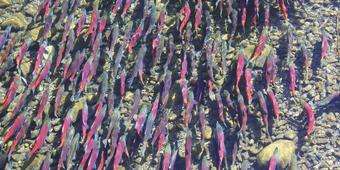Tracking animal migrations has become easier... now what?

Salmon navigate across vast swaths of open ocean and a maze of branching river networks to locate their natal waters. For years, scientists have described this as heroic feats of individuals.
More recently, though, researchers have observed that salmon migrating in large groups more accurately navigate home than salmon in smaller groups. Other species also migrate en masse over land and through air, and emerging hypotheses suggest some animals take advantage of collective navigation – a kind of group decision-making that helps get them where they're going. For scientists, though, testing these ideas in the wild can be technically and logistically difficult.
During a three-day working group at SFI, roughly a dozen ecologists and computer scientists will explore ways technologies might help researchers better understand why and how individuals in migrating groups make the choices they do.
In the past, GPS tracking has allowed researchers to study the location and movements of individuals. However, these individuals act only as trace particles (samples that indicate where the group has traveled); tracking them cannot reveal how social interactions inform group movement decisions. Recent technological advances are beginning to lift this restriction. Tracking devices such as new GPS units, passive integrated transponder (PIT) tags, and camera-laden drones have become better and less expensive, and imaging software that can identify individuals in video has grown more accurate.
As a result, researchers can capture finescale movements of many animals in parallel. "We can now get the simultaneous trajectory of every individual in a group moving together in the wild. That's really an unprecedented data set," says SFI Omidyar Fellow Andrew Berdahl, who is hosting the working group with Colin Torney of the University of Exeter. "Now the challenge is to determine how individuals are interacting with each other and with the environment, and how those interactions scale up to effective group-level migration strategies."
Provided by Santa Fe Institute



















